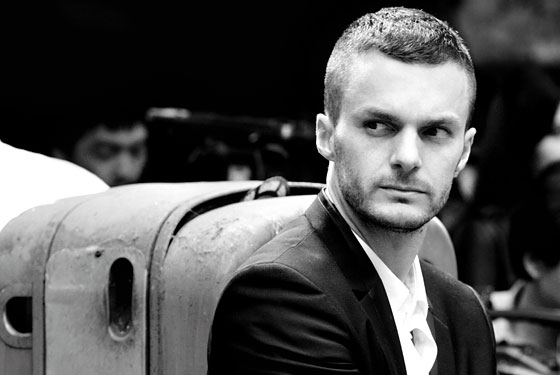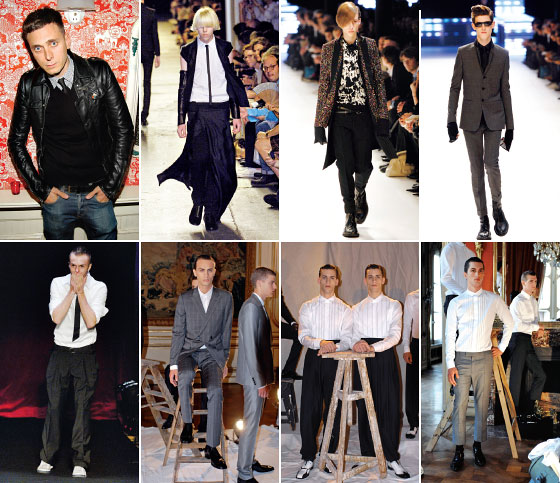
My idea of valeur and elegance is so hard to find,” says menswear designer Kris Van Assche, with a wistful sigh. A very beautiful boy has just dropped his pants to reveal a loud and hideous tattoo on his calf, and it is clear from Van Assche’s disappointed face that, despite his Grecian good looks, this boy just won’t do.
Van Assche is in final fittings for his next fashion show on a drizzly Wednesday morning. His small, clean office is bright, white, and filled with the revolving cast of handsome teenage boys (some 600, in fact, one every two minutes) who will show off his odd, sometimes-pleated suiting that, this season, has taken its cues from the quirky, nostalgic photographs of August Sander. Menswear shows in Milan have just ended, and Van Assche has been disappointed by the funny haircuts and new tattoos that have been arriving in Paris all week. Also: Too much muscle is not, for Van Assche, a good thing, and he struggles to button a jacket across an especially strapping chest. “La bonne tête, la bonne démarche,” he says sadly, “mais c’est pas la bonne veste.”
Van Assche is tall, handsome, Belgian. His pristine white shirt is quite carefully tucked half in, half out, his jeans are dark, and he is full of designer-y thoughts. “I don’t know if it’s inspired by clowns or old people, but I guess that’s the point. They are both kind of sad,” he says of Sander’s work. He likes the awkwardness of it, the formality of people from the working classes dressed up for formal portraits. “When you get old,” he says, “your neck gets skinny. And your wedding suit, it has been hanging for twenty years and it is stretched out.” He’s nostalgic for these moments, for a lot of moments, really, and has named his show “Souvenir.” It’s all very sweet and somewhat sentimental, and on each seat at his show, he will place a small lavender sachet. “He’s a romantic,” says Michael Macko, the mens fashion director at Saks. “It’s all, like, about some people in some country sewing clothes in, like, some little house.”
It’s not the typical mad fuss 24 hours before a women’s fashion show. Van Assche is organized and well prepared: Each outfit hangs on a rack beside a plastic bag of accessories (tiny clown hats, for example, that he will snap under the models’ chins and onto their foreheads, wingtips woven in silver braid). Each look has been photographed on its model several times: plainly, for the record, and then beautifully, by Van Assche himself.
It’s all very civilized in here. As one men’s editor comments, “Men’s fashion is very ladylike.”
But beneath the calm, fastidious organization, one detects a well-controlled panic in Van Assche, a slight raising of voice, darting of eyes; on Friday morning, he’ll show his own, privately backed, eponymous line in a sadly beautiful, grease-stained garage near the Bastille. On Sunday, though, he’ll be in a fancy Belle Époque mansion in the Sixteenth Arrondissement to make his debut as the designer of Dior Homme, a brand that’s been, for seven years, synonymous with the name of Hedi Slimane, Van Assche’s former boss, who left Dior just months earlier in a flurry of angry Web posts.
There has never been a menswear designer with the influence of Hedi Slimane. In his seven years at Dior (and his two years before that at YSL), Slimane created a world of super-skinny, teenage-sexy, breathless rock and roll that defined a moment, at least in fashion terms. He was anomalous as a menswear designer because he treated men’s fashion with the same urgency and lust as a women’s designer: It changed from season to season; it was an unattainable yet buyable fantasy. It was old David Bowie, it was Kate Moss and Pete Doherty, and it was endlessly, epically cool. It was not heroin chic, exactly, but not not heroin chic, either. The Slimane look was razor-sharp Parisian tailorings seen through a scrim of carefully executed rock-star grime. He found his models not only in agency-driven castings but on the street and at sweaty rock shows, and they had zits on their cheeks (sometimes) and tiny waists (always). Women wanted, and wore, Hedi. Even men who are neither gay nor Japanese (men’s capital-F fashion’s two biggest markets) wanted something by Hedi Slimane. Karl Lagerfeld lost almost 100 pounds in order to fit into a pair of Hedi Slimane pants.
But in April, a year of contract negotiations between Dior and Slimane ended. “I tried to make things work for about a year,” Slimane wrote on his Website. “Perhaps [at] another time in my life, under other circumstances, my name, and the management of a company under my own label, would be considered differently.”
What he meant, presumably, was that LVMH was not giving him enough autonomy. That the company was not going to back his own line in conjunction with a continuation of his contract at Dior (an arrangement similar to Marc Jacobs’s with Louis Vuitton).
And so Dior let him go and turned to Van Assche, who had worked for Slimane at both YSL and Dior. Van Assche had not, in fact, ever worked for anyone else, and had left Dior only to start his own label. “I wanted my own collection, my own baby,” he says. “I needed to develop my own identity.” Which he has, and it’s an identity as diametrically opposed to that of his former boss as possible. He describes it as “a grown-up man who doesn’t want to be too classic, but also is not a fashion kid,” by which he means clothes that are not stuffy but not for a rock show or a boy hustler, either.
“What is the point of coming to Paris and doing fashion,” Van Assche wonders one morning in the gilt lobby of the Plaza Athénée, “if it is not to make life more beautiful?” So what did he think of Slimane’s skinny, zitty kids? “That is not a vision of elegance,” he says carefully. “That is not what I put onstage, that is not what I relate to.”

Men’s fashion shows play a very different role in the industry from the one women’s shows do. “Men’s runway really appeals to a small percentage of consumers,” says Robert Burke, a fashion consultant. “The business being done during a men’s show is about branding. It’s attitude, it’s positioning, because these are lifestyle brands; it’s about men’s, women’s accessories, home, travel.” Men don’t respond to trends like women do: Runway pictures are scoff-worthy for a great number of men, whose style tends to change in a slow morph of details over years or even decades. When men’s fashion gets extreme—kilts! Speedos!—it tends to get giggles rather than gasps. “Look, it can be scary for me, and I get it!” Macko says.
Because men’s fashion, at its core, is conservative. Even men who are considered “well dressed” aren’t into fashion; scan any best-dressed list and you’ll find its members get their suits from tiny bespoke tailors in London and Florence. Splashy menswear launches of recent memory include Thom Browne, whose inspiration is a fifties accountant who likes stiff Scotch and racquetball, and Tom Ford, who surrounds very traditional suiting with egregious luxury and astonishing price tags. His suits aren’t radical, though their marketing is, and that, perhaps, is the key to his success. Because too much fashion on a man just isn’t, when it comes down to it, masculine enough for most men.
Van Assche’s debut for Dior was, he says, an homage to Dior’s famous atelier, a showcase for what such highly skilled hands can do. It was sort of camp Fitzgerald, with tableaux vivants of Van Assche’s beautiful, beautiful boys in endless combinations of white shirts and black trousers in every conceivable permutation: flat-fronted and narrow, full and pleated a bit, pleated a bit more, pleated all the way down the leg. “I want to bring back the feeling of a salon,” Van Assche says, “the feeling of Mr. Dior.”
But there isn’t a great tradition of “Mr. Dior,” as far as menswear is concerned. The great French houses have status because of their work in womenswear: in couture, in ready-to-wear. The men’s businesses appeared as appendages, without particular identities apart from an idea of luxury and craft, until Hedi Slimane came along.
And so this celebration of luxury and skill, perhaps, is what Van Assche means. Because it was all quite perfect, with rich, soft fabrics and precise, couture-level finishes.
The critical response was mixed: It was beautifully executed, but what was the message? But does men’s fashion really need a message? Van Assche seemed to be saying that he hadn’t quite decided on one, but that perhaps luxury and quality can be enough. Men want nice white shirts and well-tailored pants, and Dior’s atelier is more than ready to provide these things. “I don’t like fashion when it gets too theatrical,” Van Assche says. “I like my inspiration closer to reality.”
Slimane is working on his photography now, mostly, and rumors (which he declines to comment on) swirl that PPR (the group that owns Gucci) or Karl Lagerfeld is moments from backing him. But he is not currently making clothes, and he insists that he has no imminent plans to do so.
It’s not the first time a big success has found a big corporation too difficult to work with: Witness Tom Ford, Alexander McQueen, Jil Sander, Helmut Lang—all of whom struggled for creative autonomy under corporate umbrellas.
“You have to threaten to overshadow the brand, but not actually overshadow it,” says one retailer who asked not to be named, such are the relationships with these big companies. Dior needs to sell because it’s Dior, not Hedi Slimane for Dior, and that stands for something; despite his cult following (there are rumors of Hedi tattoos on some fashion forearms), Dior will work just fine as something quieter. “You do have the men’s fashion customer who knows about Hedi, who knows that there’s been a switch,” says Macko, “but that’s a very small percentage. I think ultimately, the name of the house is far bigger than any designer.”
And Van Assche can, happily, hold his neoclassical ground. “I’ve never related to things that aren’t beautiful,” he says. “I like good shape, nice skin. I spend a lot of time in libraries, and with my grandmother.
“Sometimes I am inspired by tango dancers or Arabic tribes. Sometimes it is crazy stuff, but the idea never outgrows the essence of fashion, which I believe is to make people more beautiful. An idea should never overshadow the essence of beauty. And an idea should never make things grotesque.”